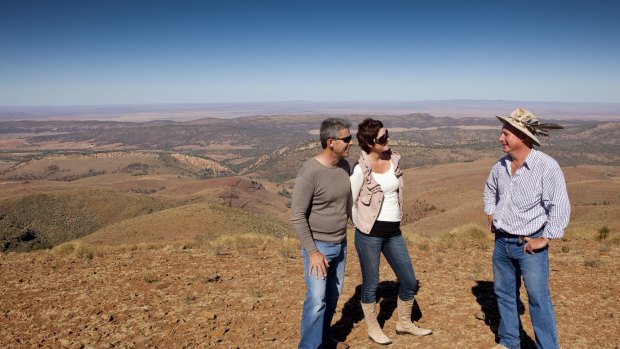This was published 9 years ago
Quorn, South Australia: Travel guide and things to do

Quorn, SACredit: John Sones
Located 334 km north of Adelaide, 40 km from Port Augusta and 293 metres above sea level, Quorn is a small service centre at the southern end of the main Flinders Ranges.
Prior to European settlement it is thought the Nugunu Aborigines lived in the area. The first European settlers arrived in the 1850s. The town came into existence in 1875 and was named after Quorndon in Leicestershire. The name was given by Governor Jervois whose private secretary came from the near Quorndon. In 1878 the government sold plots of land in the area and by 1879 it had become an important stopping point on the Great Northern Railway line when the narrow gauge railway reached Quorn from Port Augusta. However its greatest period of importance as a railway centre was between 1917 and 1937 when it was the junction for both the east to west and north to south railway services.
This importance continued through World War II when over 400 people in the town were working for the railways. During this time thousands of troops passed through the town and it has been estimated that the local branch of the Country Womens Association provided over 1 million meals to the servicemen.
The standardisation of gauges, and the establishment of the standard gauge railway to Marree in 1956, saw the town's importance decline.
Because of its location at the edge of the Flinders Ranges and its old style charm Quorn has been the setting for many scenes in many movies. The landscape and the town have been used in films as diverse as 'Gallipoli', 'The Shiralee', 'The Sundowners', 'Sunday Too Far Away' and 'Robbery Under Arms'
Things to see
Historic Walk
There is a pleasant Historic Walk through the town which includes 27 buildings and locations most of which date from the late 19th and early 20th century when the town was an important railway centre. The walk starts at the Railway Station (1916) and goes past the Austral Hotel (1878), Mathews Emporium - Quornucopia (1886), Criterion Hotel (1890), Court House (1879), Town Hall (1891), Anglican Church (1897), the Flour Mill (1878), Trancontinental Hotel (1878), Grand Junction Hotel (1890), Catholic Church (1883), Uniting Church (1879) and Lutheran Church (1890).
Pichi Richi Railway
The Pichi Richi Railway Preservation Society Inc. has, since its formation in 1973, been dedicated to the preservation, restoration and operation of the Pichi Richi Railway, the first leg of the old Central Australian Railway to Alice Springs - the old Ghan route. The society has built up a collection of historic narrow gauge rolling stock of the old South Australian and Commonwealth Railways. These are restored and operated on a voluntary basis. The line has been extended through to Port Augusta, so trains now depart from both the Quorn and Port Augusta Railways Stations on a regular basis. For more details contact (1800) 440 101.
Quorn Railway Station
The first Quorn railway station was built in 1860. This handsome limestone building was completed in 1916 and is characterised by a bull-nosed iron roofed verandah with cast iron decoration.
Quorn Mill
Situated at 2 Railway Terrace this important building was constructed for John Dunn in 1879. Dunn was one of the most successful millers in the district and took advantage of the good years in the late 1870s when the wheat crops were substantial. Unfortunately a couple of years after it was built the district experienced a period of sustained drought which drove many of the wheat farmers off the land.
Outdoor Agricultural Implements Museum
Located on the Pichi Richi Pass Road this is an interesting display of historic farm implements. The low rainfall in the district ensures that they are well preserved with little sign of rust.
Walking Trails
There are a large number of walking trails in the district. The most famous, the Heysen Trail from Cape Jervis to the Flinders, passes through Mount Brown Conservation Park to the south of the town. There are also walks in the Dutchman Stern Conservation Park which lies to the west of the town; Devils Peak, 11 km south of the town has a good 2 hour walking trail; and Moockra Tower has a scenic lookout in the Horseshoe Ranges. Maps for most of these walks can be obtained from the Tourist Information Centre at the District Council Office.
Cradock
Cradock is nothing more than a broken down petrol station, a pub and one house. Further along the road is a beautiful old church, St Gabriel's Church, which was built in 1882 and is now part of the National Heritage. It is a tiny and exotic village on the edge of the desert.
Kanyaka Ruins
Located 42 km north of Quorn on the road to Hawker, the Kanyaka Ruins are definitely worth visiting. A strange collection of ruins dating back to 1851 when Kanyaka Station was a huge wheat property (984 square kilometres) on the limits of the desert. At the time it supported a station population of nearly 70 families (working on farms at the time was labour intensive) but the inevitable droughts drove the people away so that all that is left are the ruins of the buildings. The buildings include remnants of a stable and harness room, a woolshed and an overseer's cottage. Detailed information about the ruins and their history is provided on a number of excellent information plaques which include photographs of the buildings before they became ruins.
Tourist information
Quorn Tourist Information Centre
3 Seventh St
Quorn SA 5433
Telephone: (08) 8648 6419
Facsimile: (08) 8648 6001
Sign up for the Traveller Deals newsletter
Get exclusive travel deals delivered straight to your inbox. Sign up now.